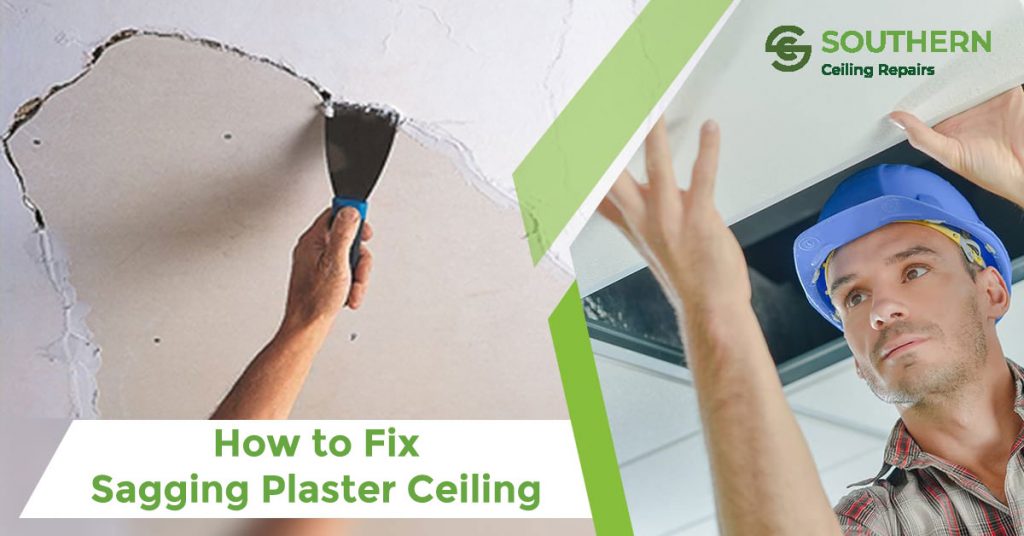
If you notice your ceiling sagging, it’s essential to act quickly. Sagging ceilings are a common issue in Australian homes and are often caused by water damage, structural problems, or incorrect installation of plasterboard.
Addressing the problem as soon as possible helps prevent further damage and keeps your home safe. This guide explains how you can fix a sagging ceiling, whether it’s a small issue or a bigger one that needs more work.
Step 1: Find Out Why the Ceiling is Sagging
Before jumping into repairs, you need to figure out what’s causing the sagging. Some of the most common reasons include:
- Water Damage
Leaks from your roof or plumbing can soak into your ceiling, weakening the materials and causing them to sag. - Structural Problems
Issues with your home’s framework might need professional assessment to check for serious damage. - Poor Installation
Sometimes, sagging happens because the plasterboard wasn’t installed properly. If the fasteners aren’t placed correctly, the plasterboard can start to droop over time.
Ceiling issues? Don’t wait! Call us today for fast and reliable service!

Step 2: Choose the Right Repair Method
Once you know why your ceiling is sagging, you can pick the best way to fix it.
1. Quick Fixes for Minor Sagging
If the sagging is small and only in one spot, you can often fix it yourself:
Reattach the Plasterboard
If the plasterboard is just hanging down slightly, you can screw it back into place. Make sure to space the screws about every 300mm along the ceiling joists to hold the board securely.
This is a simple job that you can usually finish in less than an hour, and it’s an effective way to keep the ceiling in place.
2. Bigger Repairs for Significant Sagging
If the sagging is more widespread, you might need to add extra support:
Install Support Battens
Attach wooden battens underneath the sagging area for additional strength. Apply adhesive from above and secure the battens with screws.
You’ll need to leave the supports in place for about a week while the adhesive sets properly. This method adds reinforcement and helps hold the ceiling firmly in place.
3. Full Ceiling Replacement for Major Damage
If your ceiling is badly damaged, a full replacement may be necessary:
Take Out the Old Ceiling
This involves removing the existing plasterboard and checking for any structural issues. You’ll then install new plasterboard and other materials as needed.
While this option is more involved and takes time, it provides a long-term solution, ensuring your ceiling remains stable and safe.
4. Cover-Up Option for High Ceilings
If your home has high ceilings, there’s a simpler option available:
Build a New Ceiling Below the Old One
You can construct a new ceiling just below the existing one. This saves time and reduces mess, while still providing a fresh, smooth finish.
However, keep in mind that this method will reduce your ceiling height by around 300mm.
Step 3: Extra Tips for Ceiling Repairs
Use the Right Screws
Make sure the screws you use are long enough to go at least 25mm into the framing. This will help hold the ceiling securely.
You can also use plasterboard washers for additional support if needed.
Seek Professional Advice
If you’re not confident about fixing the ceiling yourself, especially if there are structural issues, it’s best to call in a qualified contractor. They’ll have the expertise to make sure everything is done safely and properly.
Fixing sagging ceilings in Mount Barker region with Southern Ceiling Repairs doesn’t have to be a hassle. By identifying the cause of the problem and selecting the right repair method, you can quickly restore your ceiling and keep your home in top shape.
Whether you need to reattach plasterboard, add support battens, or replace the entire ceiling, acting quickly will help prevent further damage. If you’re unsure about what’s causing the sagging or need assistance, contact us for gyprock ceilings and don’t hesitate to consult a professional.
We’ll provide the right advice and help you make the best decision for your home. If you’re looking for expert help in WA Great Southern, consider plaster ceiling repair with our service and reach out to us today.
We offer professional advice and quality service to fix any ceiling issues in Perth Southern Suburbs, including how to attach a ceiling rose, ensuring your home stays safe and secure.
